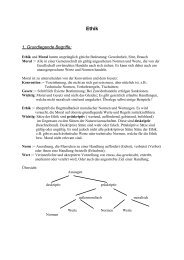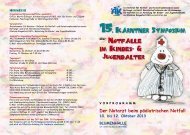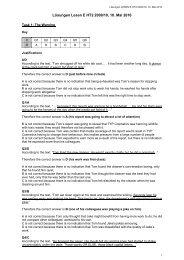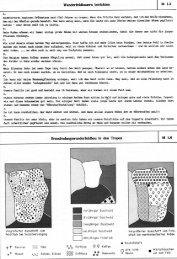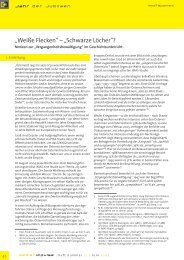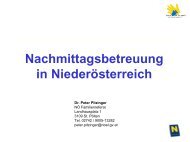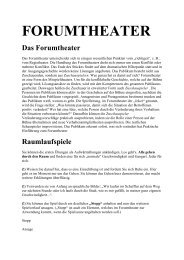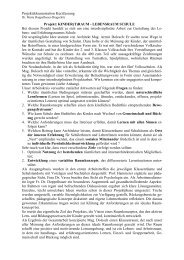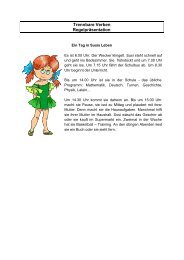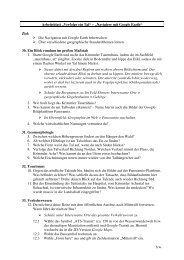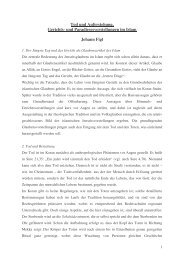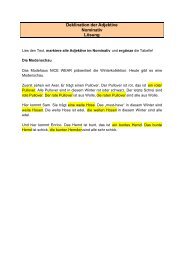Unterstufenpapierversion1#3#2005
Unterstufenpapierversion1#3#2005
Unterstufenpapierversion1#3#2005
Create successful ePaper yourself
Turn your PDF publications into a flip-book with our unique Google optimized e-Paper software.
Richtlinien zur Erstellung und Beurteilung schriftlicher Arbeiten in Englisch in der Unterstufe<br />
4. Richtlinien und Beispiele für Testformate<br />
Im folgenden Abschnitt, der sich in Hör- und Leseverstehen, English in Use und Textproduktion aufgliedert,<br />
folgt allgemeinen Ausführungen zum jeweiligen Kompetenzbereich ein so genannter Kanon, in<br />
dem sinnvolle, zu zuverlässigen Ergebnissen führende Testformate in Form von praktischen Beispielen<br />
vorgestellt werden.<br />
Einige praktische Tipps, die die Verlässlichkeit der Testformate erhöhen<br />
a) KOW factor (= knowledge of the world/Allgemeinwissen) vermeiden<br />
b) Bei matching tasks: ungleiche Anzahl an items (distractors) um Raten und Folgefehler<br />
(double jeopardy) zu verringern<br />
c) Bei True/False tasks die Kategorie Not in the text hinzufügen<br />
4.1. Hör- und Leseverstehen<br />
4.1.1. Validität<br />
Um dem Prinzip der Validität gerecht zu werden, empfehlen sich hier ausschließlich Überprüfungsformen,<br />
die eine objektive, eindeutige Bewertung der Fertigkeiten Hören oder Lesen ermöglichen. Das sind<br />
Überprüfungsformen, bei denen die sprachliche Produktion auf ein Minimum reduziert und der Erwartungshorizont<br />
bezüglich der vom Schüler wiederzugebenden Informationen möglichst eindeutig ist.<br />
4.1.2. Kanon an Testformaten für Hör- und Leseverstehen:<br />
Testformate geeignet für listening example reading<br />
Fill in grids � 4.1.2.1.a �<br />
Complete the sentences � 4.1.2.1.b �<br />
Matching sentence halves � 4.1.2.1.c �<br />
Answering questions � 4.1.2.1.d �<br />
Short answers � 4.1.2.1.e �<br />
True/ false/ not in the text � 4.1.2.1.f �<br />
Put the sentences into the correct order to make a summary � 4.1.2.1.g �<br />
Multiple choice � 4.1.2.1.h �<br />
Summarizing a text with a text skeleton � 4.1.2.1.i �<br />
Summarizing a text with sentence chunks � 4.1.2.1.j �<br />
Picture matching � 4.1.2.1.k �<br />
Filling in missing information � 4.1.2.1.l �<br />
Multiple matching � 4.1.2.1.m �<br />
Sequencing text and pictures � 4.1.2.1.n �<br />
Diagrams, maps, pictures � 4.1.2.1.o �<br />
Matching information to pictures � 4.1.2.1.p �<br />
Note taking � 4.1.2.1.q<br />
Dictation � 4.1.2.1. r<br />
Spot and underline the errors � 4.1.2.1.s �<br />
Writing a summary 4.1.2.2.a �<br />
Finding an ending/a title to a story �<br />
Finding first sentences to paragraphs 4.1.2.2.c �<br />
Matching headings to paragraphs 4.1.2.2.d �<br />
Understanding real world notices 4.1.2.2.e �<br />
Finding the gist of a text 4.1.2.2.f �<br />
Answering detailed questions 4.1.2.2.g �<br />
Reconstruction of a text 4.1.2.2. h �<br />
Finding out sentences that do not belong to the text 4.1.2.2. i �<br />
Correcting mistakes 4.1.2.2.j �<br />
Matching descriptions 4.1.2.2.k �<br />
12




